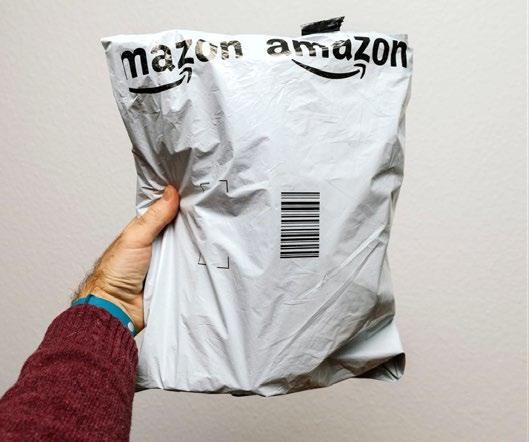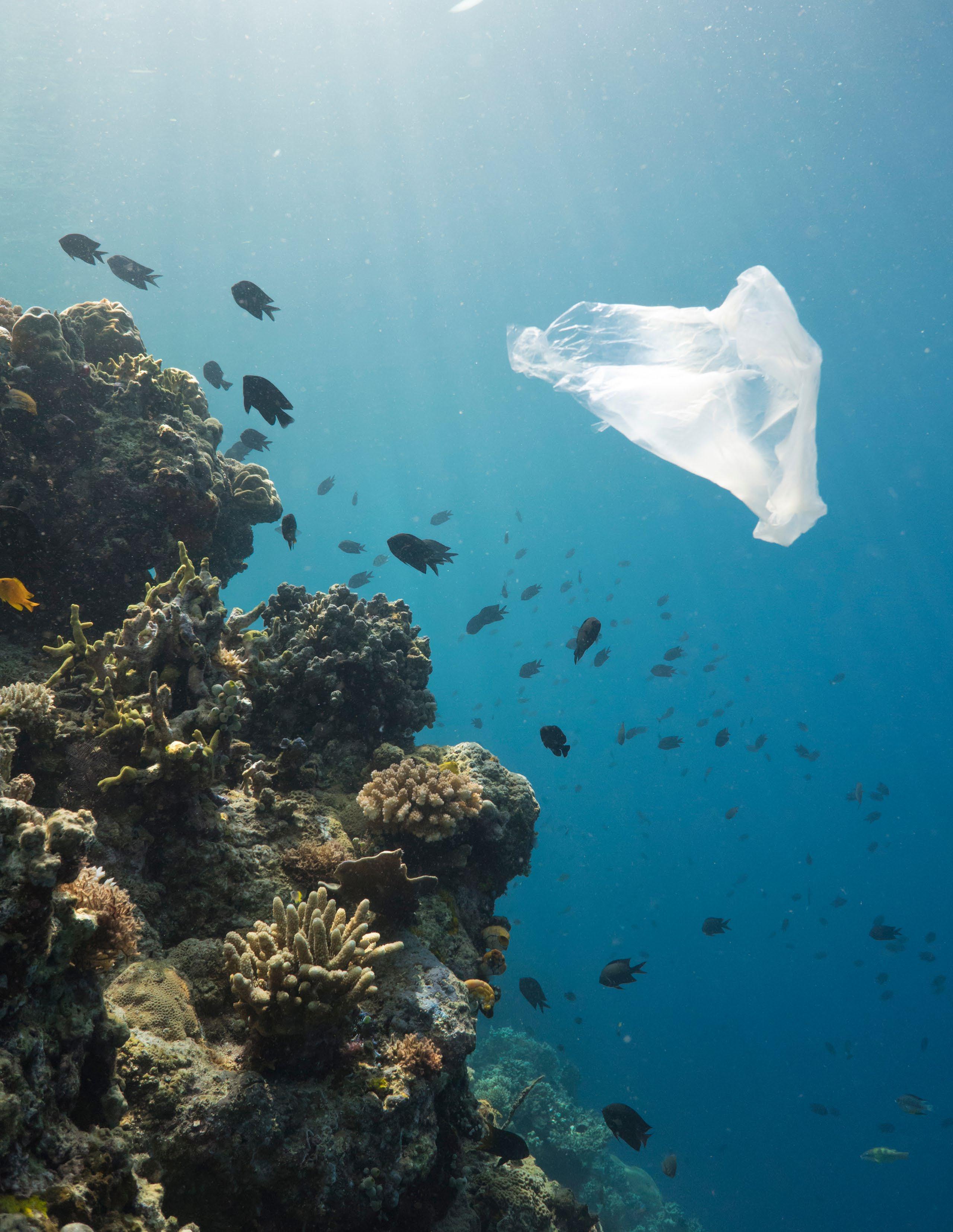
8 minute read
Executive Summary
• Oceana estimates that Amazon’s plastic packaging waste in 2020 totaled 599 million pounds, a striking one-year increase of 29%, compared to Oceana’s 2019 estimate of 465 million pounds.
This amount of plastic would, in the form of air pillows, circle the planet more than 600 times.1
Oceana also estimates, based on plastic waste pollution data from a peer-reviewed study published in Science in 2020, that up to 23.5 million pounds of this waste entered the world’s waterways and seas. That is equivalent to dumping a delivery van's payload of plastic into the oceans every 67 minutes.2
• Amazon’s recycling promises and claims do not add up and do not reduce the company’s very large plastic packaging waste footprint. The type of plastic packaging used by Amazon – plastic film – is rarely accepted by municipal recycling programs. Despite this, 39% of 1,400
Amazon Prime customers surveyed by Oceana in 25 cities in the United States and the United
Kingdom reported that they put their packaging in curbside recycling bins. Additionally, 41% of secret shoppers sent by Oceana into 186 stores Amazon claimed as alternative recycling drop-off points for plastic film (in these same 25 cities in the U.S. and UK) were told by store representatives that Amazon plastic is not accepted for recycling at their store.
• In contrast to the company’s recycling programs, Amazon's actions to eliminate single-use plastic packaging in India3 and to increase the use of returnable and reusable packaging could be – according to Oceana’s analysis – having a significant impact on reducing the company’s plastic pollution problem. If the company expands its efforts to eliminate single-use plastic packaging in India worldwide, it could substantially reduce its plastic footprint. Amazon has shown that this is possible with its reported plans to eliminate single-use plastic packaging in Germany, one of the company’s largest markets. Amazon ships hundreds of millions of packages4 a year in Germany and has a market share of more than 50%.5
• Amazon has – following rapid pandemic related growth – exceeded Walmart’s total sales6 and is the largest retailer in the world (outside of China). The company is increasingly defining how retail products are packaged. It is critical for the oceans that the company leads the reduction of plastic pollution. Amazon needs to stop hiding behind ineffective solutions like plastic film recycling and instead leverage its innovative know-how and, as shown in India, Germany, and other efforts detailed in its sustainability report7, be a leader and take steps to reduce its plastic packaging waste footprint.
Oceana analyzed e-commerce and packaging market data, as well as a recent scientific report published in Science about predicted growth in plastic waste, that projects plastic pollution of aquatic ecosystems by country and found that Amazon's enormous plastic packaging footprint increased by 29% in comparison to Oceana’s 2019 estimate. Amazon disputed Oceana’s estimate in its 2020 report. Oceana, in response, asked the company to directly provide data about its plastic footprint to Oceana, which the company has not yet done. Oceana, therefore, continues to estimate the company’s footprint based on publicly available data.
In 2020, according to Oceana’s analysis, Amazon generated an estimated 599 million pounds, or 272 million kilograms (kg), of plastic packaging. This is the plastic used to ship purchases made on Amazon.com and includes air pillows or bubble wrap used to prevent products from moving within a package, and plastic mailers and plasticlined paper envelopes to ship smaller products. Amazon packages are usually double-packed, with the original product already packaged, surrounded with plastic filling and an outer Amazon box.
E-commerce plastic packaging becomes plastic waste after a package is delivered. Almost all plastic waste is landfilled, burned, or enters and pollutes the environment, including waterways and oceans, where plastic can harm marine life.
Based on data derived from the scientific report about plastic pollution of aquatic ecosystems,8 Oceana estimates that in 2020, up to 23.5 million pounds (10.7 million kg) of Amazon's plastic packaging ended up in the world's freshwater and marine ecosystems as pollution. This amount is roughly equivalent to a delivery van's worth of plastic being dumped into major rivers, lakes, and oceans every 67 minutes.9
Plastic is a major source of pollution for the world's oceans. Scientists now estimate billions of pounds of plastic wash into the ocean every year.10 The plastics industry expects annual production will more than triple by 2050, far outpacing recycling (only 9% of all plastic waste produced to date has been recycled).11,12 Plastic packaging harms marine life and biodiversity when it enters the marine environment. Sea turtles and other animals mistake the kind of plastic used by Amazon – such as plastic bags – for food. Studies have estimated that 55% percent of sea birds, 70% of marine mammals, and 100% of sea turtles have ingested or become entangled in plastic and have found that plastic film is one of the deadliest forms of plastic for marine life.13,14
Amazon plastic packaging falls into the category “plastic film,” a material that is extremely difficult to recycle. Most curbside recycling programs in the U.S., Canada, the UK, and other large markets for Amazon do not accept or recycle plastic film. Additionally, the small amount of consumer plastic film waste that is recycled is most often downcycled and used to create other products like commercial decking (rather than more plastic packaging and plastic film15). There is little evidence of recycling of plastic film (and packaging) already used by consumers on a large scale16 and, most importantly, little evidence that plastic film recycling reduces the amount of plastic packaging waste entering landfills and the environment (and the world’s oceans).
Despite all this, Amazon promotes recycling as a solution to its large and growing plastic packaging waste problem. There are several references to plastic recycling programs in the company's recent sustainability report17,18 and on the company’s website19– Amazon Second Chance – that offers information for customers about how to recycle plastic packaging and links to alternative recycling sites. While the company offers some details about these programs, they do not specify the impact these efforts would have on reducing the company's very large plastic packaging waste footprint.
In 2021, Oceana conducted a multi-part study in 25 cities in the U.S. and the UK to investigate what happens to Amazon's plastic packaging waste, including what customers do with their packaging. Oceana surveyed 1,400 Amazon Prime customers in the 25 cities about how they dispose of their packaging and found that three out of four customers are – intentionally and unintentionally – sending their plastic packaging to the landfill.
©Shutterstock / Hadrian
• 39% of the Amazon customers surveyed put their plastic packaging in recycling bins even though this means the plastic packaging will likely end up being landfilled. 83.8% of those who reported placing their plastic in the bin believed the plastic would be recycled. • 35.5% said they simply put their Amazon packaging in the trash, 19.3% said they set the packaging aside and only 5.9% said they bring the packaging to store drop-off locations (like the ones linked to by Amazon’s
Second Chance website). • 91.4% of those surveyed said that they thought Amazon should reduce its use of plastic packaging. Nearly 95% of the Amazon Prime customers surveyed are concerned about plastic pollution's impact on the oceans.
We also sent mystery shoppers into 186 stores in these same 25 cities – identified as local recycling drop-off points for plastic packaging through links from the Amazon Second Chance website. The secret shoppers found that in 41% of these stores, representatives said they could not accept Amazon plastic packaging. Managers at more than 80% of the stores visited told the secret shoppers that they did not know their store was listed as a drop-off location for the recycling of Amazon packaging. Additionally, when the secret shoppers looked into the plastic recycling bins, they only saw Amazon packaging in the bins in 17% of the stores surveyed. Several of the bins were labeled as accepting “plastic bags only” which would presumably confuse Amazon shoppers unaware that their plastic mailers and other packaging are supposed to go in the “plastic bags only" bin.
In addition, Oceana interviewed local municipal recycling officials in the cities where the survey was conducted. Officials in both the U.S. and the UK confirmed to Oceana that they are not able to recycle Amazon plastic packaging and that this packaging continues to be put in recycling bins and contaminate other plastic.
Oceana's research found that Amazon customers do not know that municipal recycling facilities will not accept Amazon packaging for recycling (and instead put it into the landfill) and that the plastic film recycling alternative system linked to Amazon is ineffective at best.
In contrast to its U.S. promotion of the failed recycling strategy, in India, Amazon recently committed to eliminate single-use plastic packaging after the Indian government enforced a sweeping ban on all single-use plastic. If properly implemented worldwide, the elimination of single-use plastic by Amazon would significantly reduce the company’s plastic packaging footprint and contribution to marine plastic pollution. Oceana estimated that Amazon has reduced its single-use plastic packaging waste in India by 50% in this latest report based on news reports which, if correct, could reduce the company’s global plastic footprint signficantly. Unfortunately, Amazon has not publicly released data regarding its reduction of plastic packaging in India, and customer data (including unboxing videos uploaded to YouTube by Amazon customers in India) make it clear that some single-use plastic packaging is still in use.
The recent news20 that Amazon will eliminate single-use plastic packaging in Germany demonstrates that the company can switch away from plastic packaging everywhere it operates. Germany is one of Amazon’s largest markets. The company has a reported 53%21 market share in Germany. Oceana estimates that the company generated nearly 88 million pounds of single-use plastic packaging waste in Germany in 2020.
Oceana, with the support of more than one-third of the company's investors,22 calls on Amazon to take measurable steps globally to reduce its plastic footprint. Additionally, Oceana, with the backing of hundreds of thousands of individuals, calls on the company to offer plastic-free options at checkout everywhere around the world.










